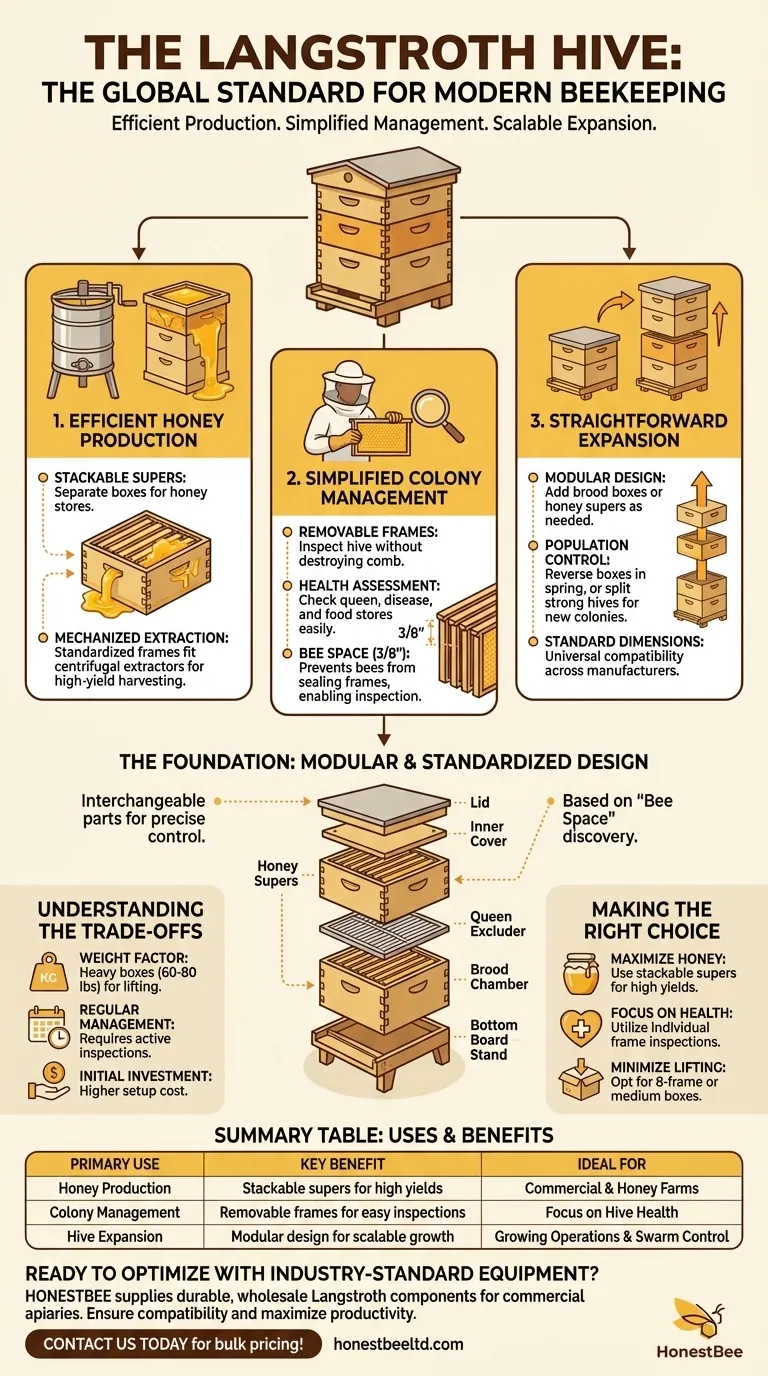The Langstroth hive is the global standard for modern beekeeping because its unique design serves three primary purposes: efficient honey production, simplified colony management, and straightforward expansion. Its modular, standardized components are used by both large-scale commercial operations and backyard hobbyists, making it the most versatile and widely supported hive system in the world.
The core advantage of the Langstroth hive is not just one feature, but how its standardized, interchangeable parts give beekeepers precise control over the colony's space, health, and productivity. This system transformed beekeeping from a passive activity into active apiary management.

The Foundation: A Modular and Standardized Design
The genius of the Langstroth hive is its construction from simple, interchangeable parts. This fundamental principle underpins all of its uses.
The Discovery of "Bee Space"
The entire system is based on the discovery of "bee space"—a gap of roughly 3/8 inch (9.5mm) that bees will naturally keep clear. By designing the hive with this exact spacing around each frame, the frames remain separate and removable, allowing a beekeeper to inspect the hive without destroying the comb.
Vertical Expansion for a Growing Colony
The hive consists of a series of stackable boxes. A new colony starts in a single brood box where the queen lays eggs, and as the population grows, the beekeeper can simply add more boxes on top for honey storage (honey supers) or additional brood space.
How Standardization Simplifies Everything
Langstroth hives are built to uniform dimensions (most commonly in 8-frame or 10-frame sizes). This means a frame, box, or lid from one manufacturer will almost always fit on a hive from another, creating a massive ecosystem of compatible equipment.
Core Uses in Beekeeping Management
The hive's design directly enables the key tasks of modern beekeeping, giving the operator an active role in the colony's success.
Streamlined Honey Production
Beekeepers add honey supers above the main brood chamber, often separated by a queen excluder to ensure the frames are filled only with honey, not eggs. Because the frames are standardized, they can be placed into a centrifuge for mechanized honey extraction, a process impossible with less structured hives.
Simplified Colony Inspections
The ability to remove frames one by one is the single most important function for colony health management. This allows the beekeeper to check for signs of disease, assess the queen's laying pattern, and verify the colony has adequate food stores.
Flexible Population and Swarm Control
The modular nature of the hive allows for advanced management. Beekeepers can reverse brood boxes in the spring to encourage expansion, or split a strong hive by moving several frames of bees and brood into a new set of boxes to create a second colony.
Understanding the Trade-offs
While dominant, the Langstroth hive is not without its challenges. Objectivity requires acknowledging its limitations.
The Weight Factor
A deep hive body or a honey super full of honey can weigh over 60-80 lbs (27-36 kg). This can make inspections and harvesting physically demanding, especially for beekeepers with mobility limitations.
Requires Regular Management
The hive's flexibility is also a responsibility. To get the most out of it and prevent issues like swarming, a beekeeper must perform regular inspections and manipulations, such as adding or removing boxes at the right time.
The Cost of Components
While individual components are affordable, a complete setup with multiple boxes, frames, a stand, feeders, and extraction tools represents a significant initial investment compared to simpler hive designs.
Making the Right Choice for Your Goal
The Langstroth hive is highly adaptable, but your specific goals should guide how you use it.
- If your primary focus is maximizing honey production: The Langstroth's stackable supers and compatibility with centrifugal extractors make it the most efficient choice.
- If your primary focus is learning and colony health: The ability to inspect individual frames provides an unparalleled view into the brood nest for disease prevention and education.
- If your primary focus is minimizing heavy lifting: Consider using an 8-frame Langstroth system or building your entire hive from medium-depth boxes to reduce the weight of each unit.
Ultimately, the Langstroth hive's enduring success lies in its ability to adapt to the beekeeper's specific goals.
Summary Table:
| Primary Use | Key Benefit | Ideal For |
|---|---|---|
| Honey Production | Stackable supers for high yields | Commercial apiaries & honey farms |
| Colony Management | Removable frames for easy inspections | Beekeepers focused on hive health |
| Hive Expansion | Modular design for scalable growth | Growing operations & swarm control |
Ready to optimize your beekeeping operation with industry-standard equipment?
As HONESTBEE, we supply durable, wholesale-priced Langstroth hive components and beekeeping supplies tailored for commercial apiaries and distributors. Our standardized frames, boxes, and accessories ensure seamless compatibility and maximize your productivity.
Contact us today to discuss bulk pricing and equipment solutions designed for your success!
Visual Guide

Related Products
- Langstroth Bee Hives Bee Keeping Box for Beginners Beekeeping
- Long Langstroth Style Horizontal Top Bar Hive for Wholesale
- Professional 3-Bar Frame Grip with Integrated Hive Tool
- Multi-Function Plier-Style Frame Grip Hive Tool
- Multi-Functional Sliding Hive Entrance for Beekeeping
People Also Ask
- What are the key features of the Langstroth beehive? A Guide to the Standard for Modern Beekeeping
- Why are Langstroth hives recommended for beginners? Unmatched Support & Standardization
- How does the ease of access differ between 8-frame and 10-frame hives? Choose the Right Hive for Your Body
- Why might a beginner be advised to start with a Langstroth hive? Unlock a Supportive Beekeeping Ecosystem
- Should a beginner try a different type of hive? Start with a Langstroth for a solid foundation.



















